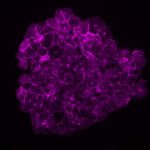Link to Pubmed [PMID] – 18525026
Link to DOI – 10.1242/jcs.026427
J Cell Sci 2008 Jun; 121(Pt 12): 2046-53
Telomeres have the capacity to recruit proteins that facilitate the spreading of heterochromatin into subtelomeric DNA regions. In the human protozoan pathogen Plasmodium falciparum, the telomere-associated protein Sir2 has been shown to control the silencing of members of virulence genes at some, but not all, chromosome-end loci, indicating that additional proteins are involved in telomere position effect. Here, we identified, in P. falciparum, a novel telomere-associated protein that displays homology with the origin-of-recognition-complex 1 protein Orc1. Antibodies raised against this P. falciparum protein localized to telomeric clusters in the nuclear periphery and the nucleolus. It was found that, prior to DNA replication, P. falciparum Orc1 and Sir2 undergo drastic subcellular reorganization, such as dissociation from the telomere cluster and spreading into the nucleus and parasite cytoplasm. Relocation of Orc1 and Sir2 was also linked to the partial dissociation of telomere clusters. Super gel-shift and chromatin-immunoprecipitation experiments showed the physical association of Orc1 with telomere repeats but revealed a differential association with adjacent non-coding repeat DNA elements. Our data suggest that Plasmodium telomeres might fold back and that Orc1 cooperates with Sir2 in telomeric silencing.



